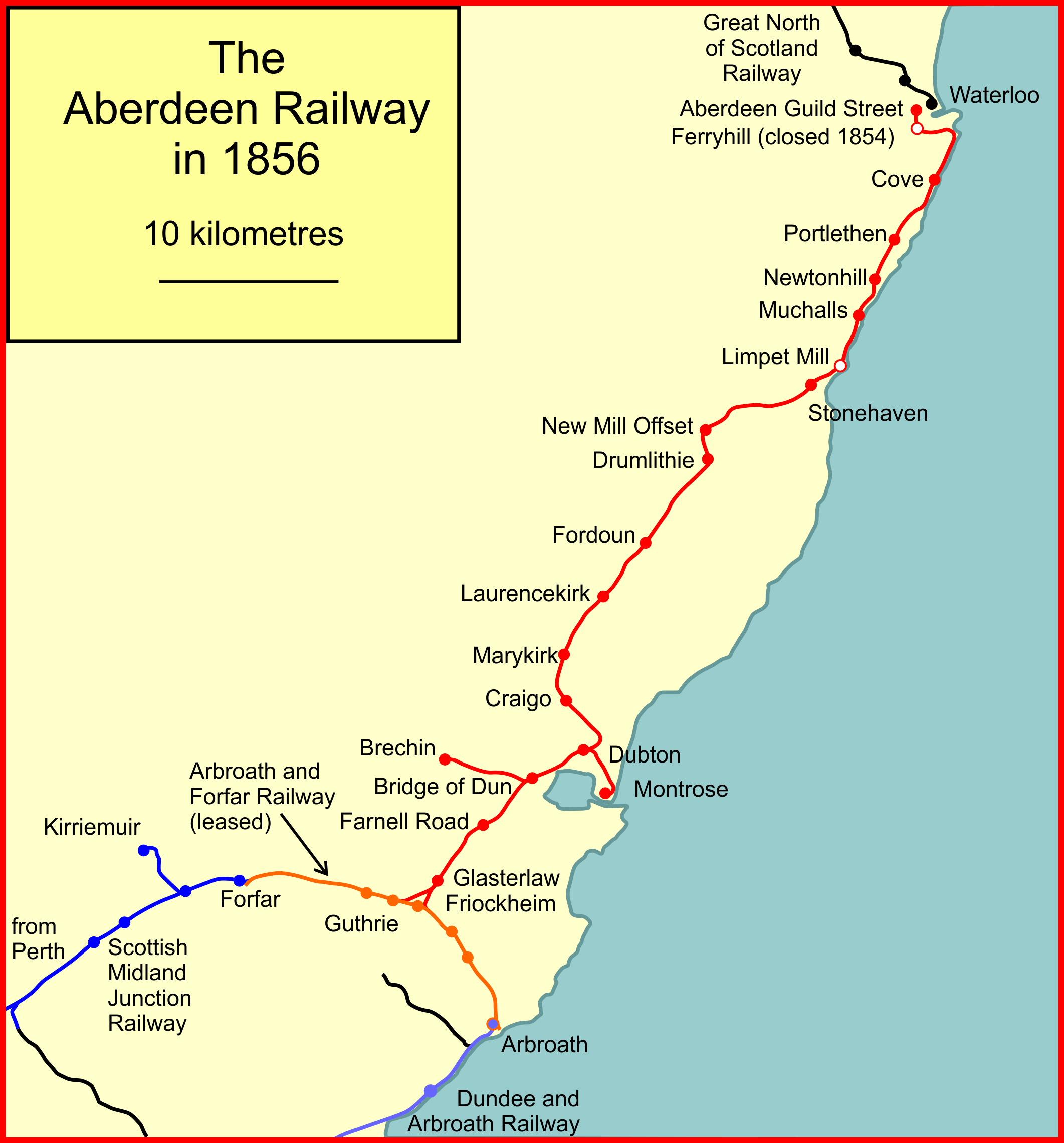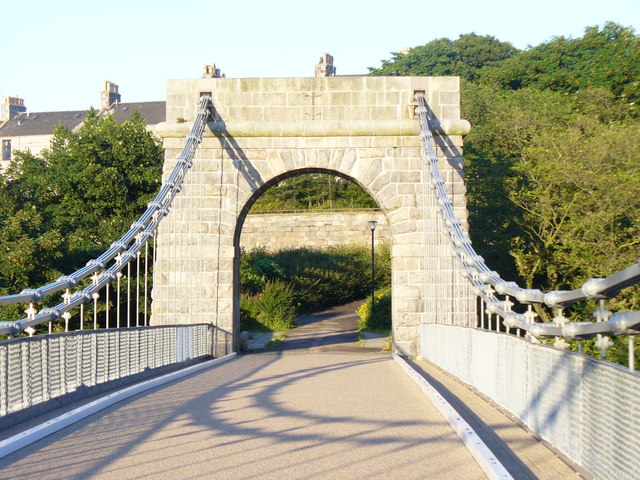|
Aberdeen Ferryhill Railway Station
Aberdeen Ferryhill railway station was the temporary terminus of the Aberdeen Railway and the first railway station to serve the city of Aberdeen. Regular passenger service began on 1 April 1850. As the station is located some distance south of the city centre, omnibuses and luggage vans were employed to complete the journey into the city. In 1853, the Deeside Railway was opened, which also used Ferryhill as a terminus. In 1854, the railway was extended and a new terminus, Aberdeen Guild Street railway station, was opened on 2 August. This station was located closer to the city centre, approximately where the present-day Aberdeen railway station (joint station) was later built. The station was situated to the west of Wellington Suspension Bridge The Wellington Suspension Bridge (also known as the Chain Bridge and Craiglug Bridge) is a suspension bridge crossing the River Dee from Ferryhill to Craiglug in Aberdeen, north east Scotland. Designed by Captain Samuel Brown and ... [...More Info...] [...Related Items...] OR: [Wikipedia] [Google] [Baidu] |
Ferryhill, Aberdeen
Ferryhill is a district in the city of Aberdeen, on the north-east coast of Scotland, United Kingdom. Duthie Park is located in the area. History The Lands of Ferryhill had belonged to the Trinity Friars, who feued them out to the powerful Menzies dynasty. After the Reformation of 1560, the Lands of Ferryhill became the property of the Crown. Dr Patrick Dun purchased the Lands of Ferryhill in 1629 for no other purpose than to bequest them, and all property thereon, by his Will to the ‘Toune of Aberdeine’ for the maintenance of 4 masters at the Grammar School. Dr Dun bequeathed the whole of this extensive property to the Provost, Baillies and Council of Aberdeen for this specific purpose. He directed that the rents obtained from these lands should be invested until enough money accumulated to buy another piece of land sufficient to yield, along with the original gift, a yearly revenue of 1,200 merks, this sum being sufficient to pay the basic salaries of the stipulated staf ... [...More Info...] [...Related Items...] OR: [Wikipedia] [Google] [Baidu] |
Aberdeen
Aberdeen (; sco, Aiberdeen ; gd, Obar Dheathain ; la, Aberdonia) is a city in North East Scotland, and is the third most populous city in the country. Aberdeen is one of Scotland's 32 local government council areas (as Aberdeen City), and has a population estimate of for the city of Aberdeen, and for the local council area making it the United Kingdom's 39th most populous built-up area. The city is northeast of Edinburgh and north of London, and is the northernmost major city in the United Kingdom. Aberdeen has a long, sandy coastline and features an oceanic climate, with cool summers and mild, rainy winters. During the mid-18th to mid-20th centuries, Aberdeen's buildings incorporated locally quarried grey granite, which may sparkle like silver because of its high mica content. Since the discovery of North Sea oil in 1969, Aberdeen has been known as the offshore oil capital of Europe. Based upon the discovery of prehistoric villages around the mouths of the rivers ... [...More Info...] [...Related Items...] OR: [Wikipedia] [Google] [Baidu] |
Aberdeen Railway
The Aberdeen Railway was a Scottish railway company which built a line from Aberdeen to Forfar and Arbroath, partly by leasing and upgrading an existing railway. The line opened in stages between 1847 and 1850, with branches to Brechin and Montrose. The Aberdeen terminus was at Ferryhill, some distance from the centre of Aberdeen. Reaching central Aberdeen was difficult, but was finally achieved in 1854. The Aberdeen Railway was reliant on other railways further south to reach central Scotland, and in 1856 the Aberdeen Railway joined with the Scottish Midland Junction Railway to form the Scottish North Eastern Railway. In the 1960s there were two routes from central Scotland to Aberdeen, and rationalisation dictated that a line from Dundee would be retained, and the original Aberdeen Railway route would close. This took place in 1967. Both routes used the same track north of Kinnaber Junction (a little north of Montrose) and this was retained; it is the only section of the ... [...More Info...] [...Related Items...] OR: [Wikipedia] [Google] [Baidu] |
Deeside Railway
The Deeside Railway was a passenger and goods railway between Aberdeen and Ballater in Aberdeenshire, Scotland. Opening in 1853 to Banchory, an extension reached Aboyne in 1859. A separate company, the Aboyne & Braemar Railway, built an extension to Ballater and this opened in 1866. By 1855 there were five services a day over the long line, taking between 1 hour 50 minutes and hours. The line was used by the Royal Train for travel to and from Balmoral Castle from 1853 and a special 'Messenger Train' ran daily when the Royal Family was in residence. The railways were absorbed by the Great North of Scotland Railway (GNSR) on 1 August 1875 for the Deeside Railway and 31 January 1876 for the Aboyne & Braemar. The line became part of the London and North Eastern Railway in 1923, and part of British Railways when nationalised in 1948. Passenger services were withdrawn on 28 February 1966 and the line was closed completely to Ballater on 18 July 1966 and to Culter on 2 January 1967 ... [...More Info...] [...Related Items...] OR: [Wikipedia] [Google] [Baidu] |
Aberdeen Guild Street Railway Station
Aberdeen Guild Street railway station was the former terminus of the Aberdeen Railway. This station opened to passengers on 2 August 1854 as the new terminus of the Aberdeen Railway, replacing the former temporary terminus at Ferryhill. It also served as the terminus of the Deeside Railway, which had an agreement to use the station and the portion of track between it and Ferryhill junction. At the time, the southern terminus of the Great North of Scotland Railway was at Kittybrewster and the two termini were connected by a tramway through the harbour. The Great North of Scotland Railway was extended in 1856 bringing the new terminus, Aberdeen Waterloo closer to the city centre, but still not connected to the Guild Street station. On 4 November 1867 the Denburn Valley Line and the new Joint station was opened. This connected the Great North of Scotland Railway and the Aberdeen Railway, which had since become the Scottish North Eastern Railway, which was in turn absorbed by the ... [...More Info...] [...Related Items...] OR: [Wikipedia] [Google] [Baidu] |
Aberdeen Railway Station
, symbol_location = gb , symbol = rail , image = Aberdeen station 01, August 2013.JPG , caption = Concourse at Aberdeen station (2013) , borough = Aberdeen, City of Aberdeen , country = Scotland , coordinates = , grid_name = Grid reference , grid_position = , manager = ScotRail , platforms = 5 (numbered 3–7) , code = ABD , original = Denburn Valley Line , pregroup = CR & GNoSR , postgroup = LMS & LNER , years = 4 November 1867 , events = Station opened as Aberdeen Joint to replace ' and 'Butt (1995), page 12 , years1 = 1913–1916 , events1 = Rebuilt , years2 = 1952 , events2 = Renamed Aberdeen , years3 = 2007–2008 , events3 = Major refurbishment , mpassengers = , footnotes = Passenger statistics from the Office of Rail and Road , embedded = Aberdeen railway station is the main railway station in Aberdeen, Scotland. It is the busiest railway station in Scotland north of the major cities of Glasgow and Edinburgh. It is located on Guild ... [...More Info...] [...Related Items...] OR: [Wikipedia] [Google] [Baidu] |
Wellington Suspension Bridge
The Wellington Suspension Bridge (also known as the Chain Bridge and Craiglug Bridge) is a suspension bridge crossing the River Dee from Ferryhill to Craiglug in Aberdeen, north east Scotland. Designed by Captain Samuel Brown and the Aberdeen City Architect John Smith, it was opened to pedestrians in November 1830 and to traffic in May 1831. The chain bridge was closed in 1984 to vehicles and then pedestrians in 2002, but was restored in 2006/07 and pedestrian use was re-instated in 2008. History Aberdeen was undergoing rapid expansion in the early 19th century and landowners in Torry, the Menzies family of Pitfodels, wished to capitalise on the opportunities arising from the establishment of the turnpike road between Aberdeen and Stonehaven in 1799. A series of legal disputes as to exact ownership of the lands ended in arbitration. An Act of Parliament was eventually obtained by the Heritors of Nigg and the Road Trustees in 1828 for a bridge to replace the Craiglug Ferry. ... [...More Info...] [...Related Items...] OR: [Wikipedia] [Google] [Baidu] |
Railway Stations In Great Britain Opened In 1850
Rail transport (also known as train transport) is a means of transport that transfers passengers and goods on wheeled vehicles running on rails, which are incorporated in tracks. In contrast to road transport, where the vehicles run on a prepared flat surface, rail vehicles (rolling stock) are directionally guided by the tracks on which they run. Tracks usually consist of steel rails, installed on sleepers (ties) set in ballast, on which the rolling stock, usually fitted with metal wheels, moves. Other variations are also possible, such as "slab track", in which the rails are fastened to a concrete foundation resting on a prepared subsurface. Rolling stock in a rail transport system generally encounters lower frictional resistance than rubber-tyred road vehicles, so passenger and freight cars (carriages and wagons) can be coupled into longer trains. The operation is carried out by a railway company, providing transport between train stations or freight customer facili ... [...More Info...] [...Related Items...] OR: [Wikipedia] [Google] [Baidu] |





